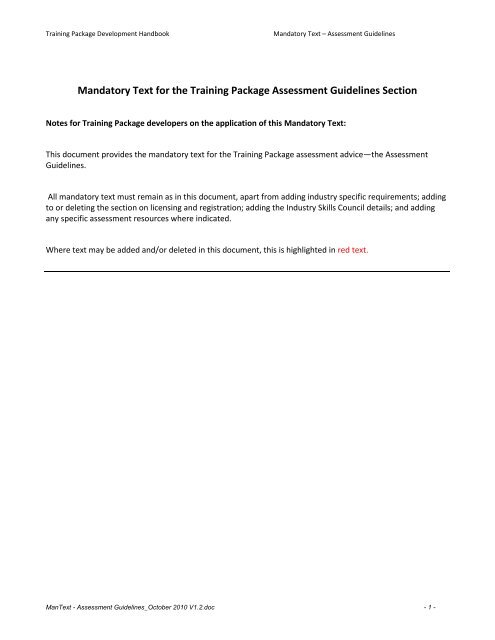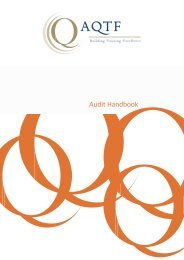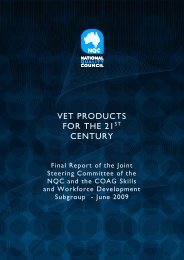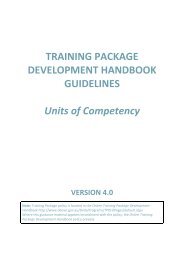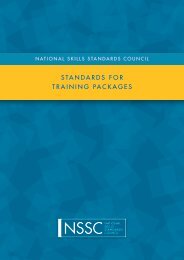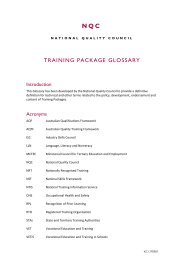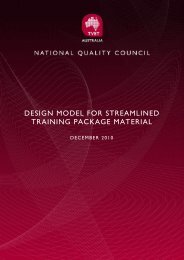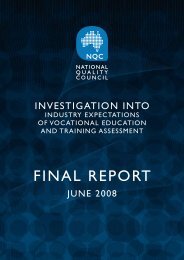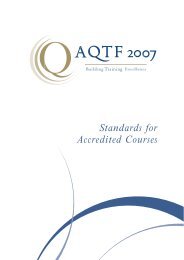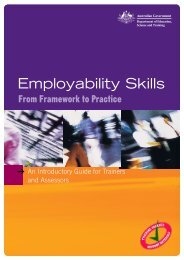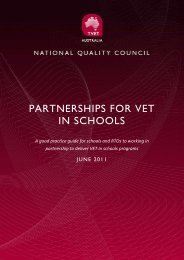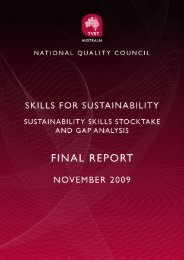Mandatory Text for the Training Package Assessment Guidelines
Mandatory Text for the Training Package Assessment Guidelines
Mandatory Text for the Training Package Assessment Guidelines
Create successful ePaper yourself
Turn your PDF publications into a flip-book with our unique Google optimized e-Paper software.
<strong>Training</strong> <strong>Package</strong> Development Handbook<br />
<strong>Mandatory</strong> <strong>Text</strong> – <strong>Assessment</strong> <strong>Guidelines</strong><br />
<strong>Mandatory</strong> <strong>Text</strong> <strong>for</strong> <strong>the</strong> <strong>Training</strong> <strong>Package</strong> <strong>Assessment</strong> <strong>Guidelines</strong> Section<br />
Notes <strong>for</strong> <strong>Training</strong> <strong>Package</strong> developers on <strong>the</strong> application of this <strong>Mandatory</strong> <strong>Text</strong>:<br />
This document provides <strong>the</strong> mandatory text <strong>for</strong> <strong>the</strong> <strong>Training</strong> <strong>Package</strong> assessment advice—<strong>the</strong> <strong>Assessment</strong><br />
<strong>Guidelines</strong>.<br />
All mandatory text must remain as in this document, apart from adding industry specific requirements; adding<br />
to or deleting <strong>the</strong> section on licensing and registration; adding <strong>the</strong> Industry Skills Council details; and adding<br />
any specific assessment resources where indicated.<br />
Where text may be added and/or deleted in this document, this is highlighted in red text.<br />
Man<strong>Text</strong> - <strong>Assessment</strong> <strong>Guidelines</strong>_October 2010 V1.2.doc - 1 -
<strong>Training</strong> <strong>Package</strong> Development Handbook<br />
<strong>Mandatory</strong> <strong>Text</strong> – <strong>Assessment</strong> <strong>Guidelines</strong><br />
<strong>Assessment</strong> <strong>Guidelines</strong><br />
Introduction<br />
These <strong>Assessment</strong> <strong>Guidelines</strong> provide <strong>the</strong> endorsed framework <strong>for</strong> assessment of units of competency in this<br />
<strong>Training</strong> <strong>Package</strong>. They are designed to ensure that assessment is consistent with <strong>the</strong> Australian Quality<br />
<strong>Training</strong> Framework (AQTF) Essential Standards <strong>for</strong> Initial and Continuing Registration. <strong>Assessment</strong>s against <strong>the</strong><br />
units of competency in this <strong>Training</strong> <strong>Package</strong> must be carried out in accordance with <strong>the</strong>se <strong>Assessment</strong><br />
<strong>Guidelines</strong>.<br />
<strong>Assessment</strong> System Overview<br />
This section provides an overview of <strong>the</strong> requirements <strong>for</strong> assessment when using this <strong>Training</strong> <strong>Package</strong>,<br />
including a summary of <strong>the</strong> AQTF requirements; licensing and registration requirements; and assessment<br />
pathways.<br />
Quality assessment underpins <strong>the</strong> credibility of <strong>the</strong> vocational education and training sector. The <strong>Assessment</strong><br />
<strong>Guidelines</strong> of a <strong>Training</strong> <strong>Package</strong> are an important tool in supporting quality assessment.<br />
<strong>Assessment</strong> within <strong>the</strong> National Skills Framework is <strong>the</strong> process of collecting evidence and making judgements<br />
about whe<strong>the</strong>r competency has been achieved to confirm whe<strong>the</strong>r an individual can per<strong>for</strong>m to <strong>the</strong> standards<br />
expected in <strong>the</strong> workplace, as expressed in <strong>the</strong> relevant endorsed unit of competency.<br />
<strong>Assessment</strong> must be carried out in accordance with <strong>the</strong>:<br />
- benchmarks <strong>for</strong> assessment<br />
- specific industry requirements [where industry specific requirements are adequately covered by<br />
<strong>the</strong> <strong>Training</strong> <strong>Package</strong> <strong>Assessment</strong> <strong>Guidelines</strong> <strong>Mandatory</strong> <strong>Text</strong>, this dot point should be deleted]<br />
- principles of assessment<br />
- rules of evidence<br />
- assessment requirements set out in <strong>the</strong> AQTF<br />
Benchmarks <strong>for</strong> <strong>Assessment</strong><br />
The endorsed units of competency in this <strong>Training</strong> <strong>Package</strong> are <strong>the</strong> benchmarks <strong>for</strong> assessment. As such, <strong>the</strong>y<br />
provide <strong>the</strong> basis <strong>for</strong> nationally recognised Australian Qualifications Framework (AQF) qualifications and<br />
Statements of Attainment issued by Registered <strong>Training</strong> Organisations (RTOs).<br />
Industry Requirements<br />
Where necessary, Industry requirements additional to <strong>the</strong> <strong>Training</strong> <strong>Package</strong> <strong>Assessment</strong> <strong>Guidelines</strong> can be<br />
inserted here.<br />
This may include advice on:<br />
- <strong>the</strong> context in which assessment is conducted,<br />
- industry workplace conditions and expectations,<br />
- realistic simulated work environments that are acceptable to industry; and<br />
Man<strong>Text</strong> - <strong>Assessment</strong> <strong>Guidelines</strong>_October 2010 V1.2.doc - 2 -
<strong>Training</strong> <strong>Package</strong> Development Handbook<br />
<strong>Mandatory</strong> <strong>Text</strong> – <strong>Assessment</strong> <strong>Guidelines</strong><br />
- in general terms, of suitable/current resources and equipment.<br />
[NOTE: where industry specific requirements are adequately covered by <strong>the</strong> <strong>Training</strong> <strong>Package</strong> <strong>Assessment</strong><br />
<strong>Guidelines</strong> <strong>Mandatory</strong> <strong>Text</strong>, this section should be deleted.<br />
Principles of <strong>Assessment</strong><br />
All assessments carried out by RTOs are required to demonstrate compliance with <strong>the</strong> principles of assessment:<br />
- validity<br />
- reliability<br />
- flexibility<br />
- fairness<br />
- sufficiency<br />
These principles must be addressed in <strong>the</strong>:<br />
- design, establishment and management of <strong>the</strong> assessment system <strong>for</strong> this <strong>Training</strong> <strong>Package</strong><br />
- development of assessment tools, and<br />
- <strong>the</strong> conduct of assessment.<br />
Validity<br />
<strong>Assessment</strong> is valid when <strong>the</strong> process is sound and assesses what it claims to assess. Validity requires that:<br />
(a)<br />
(b)<br />
(c)<br />
assessment against <strong>the</strong> units of competency must cover <strong>the</strong> broad range of skills and knowledge that<br />
are essential to competent per<strong>for</strong>mance<br />
assessment of knowledge and skills must be integrated with <strong>the</strong>ir practical application<br />
judgement of competence must be based on sufficient evidence (that is, evidence ga<strong>the</strong>red on a<br />
number of occasions and in a range of contexts using different assessment methods). The specific<br />
evidence requirements of each unit of competency provide advice on sufficiency<br />
Reliability<br />
Reliability refers to <strong>the</strong> degree to which evidence presented <strong>for</strong> assessment is consistently interpreted and<br />
results in consistent assessment outcomes. Reliability requires <strong>the</strong> assessor to have <strong>the</strong> required competencies<br />
in assessment and relevant vocational competencies (or to assess in conjunction with someone who has <strong>the</strong><br />
vocational competencies). It can only be achieved when assessors share a common interpretation of <strong>the</strong><br />
assessment requirements of <strong>the</strong> unit(s) being assessed.<br />
Flexibility<br />
To be flexible, assessment should reflect <strong>the</strong> candidate’s needs; provide <strong>for</strong> recognition of competencies no<br />
matter how, where or when <strong>the</strong>y have been acquired; draw on a range of methods appropriate to <strong>the</strong> context,<br />
competency and <strong>the</strong> candidate; and support continuous competency development.<br />
Man<strong>Text</strong> - <strong>Assessment</strong> <strong>Guidelines</strong>_October 2010 V1.2.doc - 3 -
<strong>Training</strong> <strong>Package</strong> Development Handbook<br />
<strong>Mandatory</strong> <strong>Text</strong> – <strong>Assessment</strong> <strong>Guidelines</strong><br />
Fairness<br />
Fairness in assessment requires consideration of <strong>the</strong> individual candidate’s needs and characteristics, and any<br />
reasonable adjustments that need to be applied to take account of <strong>the</strong>m. It requires clear communication<br />
between <strong>the</strong> assessor and <strong>the</strong> candidate to ensure that <strong>the</strong> candidate is fully in<strong>for</strong>med about, understands and<br />
is able to participate in, <strong>the</strong> assessment process, and agrees that <strong>the</strong> process is appropriate. It also includes an<br />
opportunity <strong>for</strong> <strong>the</strong> person being assessed to challenge <strong>the</strong> result of <strong>the</strong> assessment and to be reassessed if<br />
necessary.<br />
Sufficiency<br />
Sufficiency relates to <strong>the</strong> quality and quantity of evidence assessed. It requires collection of enough<br />
appropriate evidence to ensure that all aspects of competency have been satisfied and that competency can be<br />
demonstrated repeatedly. Supplementary sources of evidence may be necessary. The specific evidence<br />
requirements of each unit of competency provide advice on sufficiency. Sufficiency is also one of <strong>the</strong> rules of<br />
evidence.<br />
Rules of Evidence<br />
The rules of evidence guide <strong>the</strong> collection of evidence that address <strong>the</strong> principles of validity and reliability,<br />
guiding <strong>the</strong> collection of evidence to ensure that it is valid, sufficient, current and au<strong>the</strong>ntic.<br />
Valid<br />
Valid evidence must relate directly to <strong>the</strong> requirements of <strong>the</strong> unit of competency. In ensuring evidence is<br />
valid, assessors must ensure that <strong>the</strong> evidence collected supports demonstration of <strong>the</strong> outcomes and<br />
per<strong>for</strong>mance requirements of <strong>the</strong> unit of competency toge<strong>the</strong>r with <strong>the</strong> knowledge and skills necessary <strong>for</strong><br />
competent per<strong>for</strong>mance. Valid evidence must encapsulate <strong>the</strong> breadth and depth of <strong>the</strong> unit of competency,<br />
which will necessitate using a number of different assessment methods.<br />
Sufficient<br />
Sufficiency relates to <strong>the</strong> quality and quantity of evidence assessed. It requires collection of enough<br />
appropriate evidence to ensure that all aspects of competency have been satisfied and that competency can be<br />
demonstrated repeatedly. Supplementary sources of evidence may be necessary. The specific evidence<br />
requirements of each unit of competency provide advice on sufficiency.<br />
Current<br />
In assessment, currency relates to <strong>the</strong> age of <strong>the</strong> evidence presented by a candidate to demonstrate that <strong>the</strong>y<br />
are still competent. Competency requires demonstration of current per<strong>for</strong>mance, so <strong>the</strong> evidence collected<br />
must be from ei<strong>the</strong>r <strong>the</strong> present or <strong>the</strong> very recent past.<br />
Au<strong>the</strong>ntic<br />
To accept evidence as au<strong>the</strong>ntic, an assessor must be assured that <strong>the</strong> evidence presented <strong>for</strong> assessment is<br />
<strong>the</strong> candidate’s own work.<br />
Man<strong>Text</strong> - <strong>Assessment</strong> <strong>Guidelines</strong>_October 2010 V1.2.doc - 4 -
<strong>Training</strong> <strong>Package</strong> Development Handbook<br />
<strong>Mandatory</strong> <strong>Text</strong> – <strong>Assessment</strong> <strong>Guidelines</strong><br />
<strong>Assessment</strong> Requirements of <strong>the</strong> Australian Quality <strong>Training</strong> Framework<br />
<strong>Assessment</strong> leading to nationally recognised AQF qualifications and Statements of Attainment in <strong>the</strong> vocational<br />
education and training sector must meet <strong>the</strong> requirements of <strong>the</strong> AQTF as expressed in <strong>the</strong> AQTF 2010<br />
Essential Standards <strong>for</strong> Registration.<br />
The AQTF 2010 Essential Standards <strong>for</strong> Initial and Continuing Registration can be downloaded from<br />
.<br />
The following points summarise <strong>the</strong> assessment requirements.<br />
Registration of <strong>Training</strong> Organisations<br />
<strong>Assessment</strong> must be conducted by, or on behalf of, an RTO <strong>for</strong>mally registered by a State or Territory<br />
Registering Body in accordance with <strong>the</strong> AQTF. The RTO must have <strong>the</strong> specific units of competency and/or<br />
AQF qualifications on its scope of registration.<br />
Quality <strong>Training</strong> and <strong>Assessment</strong><br />
Each RTO must provide quality training and assessment across all its operations. See <strong>the</strong> AQTF 2010 Essential<br />
Standards <strong>for</strong> Initial and Continuing Registration, Standard 1.<br />
Assessor Competency Requirements<br />
Each person involved in training and assessment must be competent <strong>for</strong> <strong>the</strong> functions <strong>the</strong>y per<strong>for</strong>m. See <strong>the</strong><br />
AQTF 2010 Essential Standards <strong>for</strong> Initial and Continuing Registration, Standard 1 <strong>for</strong> assessor (and trainer)<br />
competency requirements. See also <strong>the</strong> AQTF 2010 Users’ Guide to <strong>the</strong> Essential Standards <strong>for</strong> Registration –<br />
Appendix 2.<br />
<strong>Assessment</strong> Requirements<br />
The RTOs assessments, including RPL, must meet <strong>the</strong> requirements of <strong>the</strong> relevant endorsed <strong>Training</strong> <strong>Package</strong>.<br />
See <strong>the</strong> AQTF 2010 Essential Standards <strong>for</strong> Initial and Continuing Registration.<br />
<strong>Assessment</strong> Strategies<br />
Each RTO must have strategies <strong>for</strong> training and assessment that meet <strong>the</strong> requirements of <strong>the</strong> relevant <strong>Training</strong><br />
<strong>Package</strong> or accredited course and are developed in consultation with industry stakeholders. See <strong>the</strong> AQTF 2010<br />
Essential Standards <strong>for</strong> Initial and Continuing Registration.<br />
National Recognition<br />
Each RTO must recognise <strong>the</strong> AQF qualifications and Statements of Attainment issued by any o<strong>the</strong>r RTO. See<br />
<strong>the</strong> AQTF 2010 Essential Standards <strong>for</strong> Initial and Continuing Registration..<br />
Access and Equity and Client Outcomes<br />
Each RTO must adhere to <strong>the</strong> principles of access and equity and maximise outcomes <strong>for</strong> its clients. See <strong>the</strong><br />
AQTF 2010 Essential Standards <strong>for</strong> Initial and Continuing Registration.<br />
Monitoring <strong>Assessment</strong>s<br />
<strong>Training</strong> and/or assessment provided on behalf of <strong>the</strong> RTO must be monitored to ensure that it is in accordance<br />
with all aspects of <strong>the</strong> AQTF 2010 Essential Standards <strong>for</strong> Initial and Continuing Registration.<br />
Recording <strong>Assessment</strong> Outcomes<br />
Each RTO must manage records to ensure <strong>the</strong>ir accuracy and integrity. See <strong>the</strong> AQTF 2010 Essential Standards<br />
Man<strong>Text</strong> - <strong>Assessment</strong> <strong>Guidelines</strong>_October 2010 V1.2.doc - 5 -
<strong>Training</strong> <strong>Package</strong> Development Handbook<br />
<strong>Mandatory</strong> <strong>Text</strong> – <strong>Assessment</strong> <strong>Guidelines</strong><br />
<strong>for</strong> Initial and Continuing Registration.<br />
Issuing AQF qualifications and Statement of Attainment<br />
Each RTO must issue AQF qualifications and Statements of Attainment that meet <strong>the</strong> requirements of <strong>the</strong><br />
current AQF Implementation Handbook and <strong>the</strong> endorsed <strong>Training</strong> <strong>Package</strong>s within <strong>the</strong> scope of its registration.<br />
An AQF qualification is issued once <strong>the</strong> full requirements <strong>for</strong> a qualification, as specified in <strong>the</strong> nationally<br />
endorsed <strong>Training</strong> <strong>Package</strong> are met. A Statement of Attainment is issued when an individual has completed one<br />
or more units of competency from nationally recognised qualification(s)/courses(s). See <strong>the</strong> AQTF and <strong>the</strong><br />
edition of <strong>the</strong> AQF Implementation Handbook—available on <strong>the</strong> AQF Council website <br />
Licensing/Registration Requirements<br />
[Note: Where <strong>the</strong> developer considers that licensing and/or registration requirements <strong>for</strong> <strong>the</strong> industry or<br />
sector covered by <strong>the</strong> <strong>Training</strong> <strong>Package</strong> DO NOT APPLY, insert <strong>the</strong> following two paragraphs, delete <strong>the</strong> rest<br />
of <strong>the</strong> section on licensing/registration, <strong>the</strong>n delete this italicised text.]<br />
This section provides in<strong>for</strong>mation on licensing/registration requirements <strong>for</strong> this <strong>Training</strong> <strong>Package</strong>,<br />
with <strong>the</strong> following important disclaimer.<br />
The developers of this <strong>Training</strong> <strong>Package</strong> consider that no licensing or registration requirements<br />
apply to RTOs, assessors or candidates with respect to this <strong>Training</strong> <strong>Package</strong>. Contact <strong>the</strong> relevant<br />
State or Territory Department(s) to check if <strong>the</strong>re are any licensing or registration requirements<br />
with which you must comply. For fur<strong>the</strong>r in<strong>for</strong>mation on this topic contact [insert a contact/URL<br />
<strong>for</strong> <strong>the</strong> latest in<strong>for</strong>mation on licensing/registration requirements – <strong>the</strong> website of <strong>the</strong><br />
Industry Skills Council may be appropriate, <strong>the</strong>n delete this text].<br />
[Note: Where licensing and/or registration requirements <strong>for</strong> <strong>the</strong> industry or sector covered by <strong>the</strong> <strong>Training</strong><br />
<strong>Package</strong> DO APPLY, delete <strong>the</strong> above two paragraphs, add in <strong>the</strong> details below, and delete this italicised<br />
text.]<br />
This section provides in<strong>for</strong>mation on licensing/registration requirements <strong>for</strong> this <strong>Training</strong> <strong>Package</strong>,<br />
with <strong>the</strong> following important disclaimer.<br />
Licensing and registration requirements that apply to specific industries, and vocational education<br />
and training, vary between each State and Territory, and can regularly change. The developers of<br />
this <strong>Training</strong> <strong>Package</strong> consider that <strong>the</strong> licensing/registration requirements described in this section<br />
apply to RTOs, assessors or candidates with respect to this <strong>Training</strong> <strong>Package</strong>. While reasonable care<br />
has been taken in its preparation, <strong>the</strong> developers of this <strong>Training</strong> <strong>Package</strong> and <strong>the</strong> Department<br />
cannot guarantee that <strong>the</strong> list is definitive or accurate at <strong>the</strong> time of reading; <strong>the</strong> in<strong>for</strong>mation in<br />
this section is provided in good faith on that basis.<br />
Contact <strong>the</strong> relevant State or Territory Department(s) to check if <strong>the</strong> licensing/registration<br />
requirements described below still apply, and to check if <strong>the</strong>re are any o<strong>the</strong>rs with which you must<br />
comply. For fur<strong>the</strong>r in<strong>for</strong>mation contact [Note insert a contact/URL <strong>for</strong> <strong>the</strong> latest in<strong>for</strong>mation on<br />
licensing/registration requirements – <strong>the</strong> website of <strong>the</strong> Industry Skills Council may be<br />
appropriate, <strong>the</strong>n delete this text].<br />
Requirements <strong>for</strong> Assessors<br />
In order to conduct assessment <strong>for</strong> statutory licensing or o<strong>the</strong>r industry registration requirements,<br />
assessors must meet <strong>the</strong> requirements outlined in <strong>the</strong> following chart, in addition to <strong>the</strong> AQTF<br />
Man<strong>Text</strong> - <strong>Assessment</strong> <strong>Guidelines</strong>_October 2010 V1.2.doc - 6 -
<strong>Training</strong> <strong>Package</strong> Development Handbook<br />
<strong>Mandatory</strong> <strong>Text</strong> – <strong>Assessment</strong> <strong>Guidelines</strong><br />
requirements.<br />
LICENCE/REGISTRATION JURISDICTION REQUIREMENTS<br />
These requirements may be met through [Note: insert relevant in<strong>for</strong>mation detailing how <strong>the</strong>se<br />
requirements may be met, including name, address and contact details of appropriate providers,<br />
<strong>the</strong>n delete this italicised text].<br />
Pathways<br />
The competencies in this <strong>Training</strong> <strong>Package</strong> may be attained in a number of ways including through:<br />
<br />
<br />
<br />
<br />
<strong>for</strong>mal or in<strong>for</strong>mal education and training<br />
experiences in <strong>the</strong> workplace<br />
general life experience, and/or<br />
any combination of <strong>the</strong> above.<br />
<strong>Assessment</strong> under this <strong>Training</strong> <strong>Package</strong> leading to an AQF qualification or Statement of Attainment may follow<br />
a learning and assessment pathway, or a recognition pathway, or a combination of <strong>the</strong> two as illustrated in <strong>the</strong><br />
following diagram.<br />
Units of<br />
Competency<br />
Learning and <strong>Assessment</strong> Pathways <br />
<br />
and/or<br />
<br />
<br />
Credit Pathways<br />
(RPL and Credit Transfer)<br />
<br />
Statement of<br />
Attainment and/or<br />
qualification under<br />
<strong>the</strong> Australian<br />
Qualifications<br />
Framework<br />
Each of <strong>the</strong>se assessment pathways leads to full recognition of competencies held – <strong>the</strong> critical issue is that <strong>the</strong><br />
candidate is competent, not how <strong>the</strong> competency was acquired.<br />
<strong>Assessment</strong>, by any pathway, must comply with <strong>the</strong> assessment requirements set out in <strong>the</strong> <strong>Assessment</strong><br />
<strong>Guidelines</strong> of <strong>the</strong> <strong>Training</strong> <strong>Package</strong> , <strong>the</strong> AQTF and, where relevant, <strong>the</strong> Australian Qualifications Framework.<br />
Learning and <strong>Assessment</strong> Pathways<br />
Usually, learning and assessment are integrated, with evidence being collected and feedback provided to <strong>the</strong><br />
candidate at anytime throughout <strong>the</strong> learning and assessment process.<br />
Learning and assessment pathways may include structured programs in a variety of contexts using a range of<br />
Man<strong>Text</strong> - <strong>Assessment</strong> <strong>Guidelines</strong>_October 2010 V1.2.doc - 7 -
<strong>Training</strong> <strong>Package</strong> Development Handbook<br />
<strong>Mandatory</strong> <strong>Text</strong> – <strong>Assessment</strong> <strong>Guidelines</strong><br />
strategies to meet different learner needs. Structured learning and assessment programs could be: groupbased,<br />
work-based, project-based, self-paced, action learning-based; conducted by distance or e-learning;<br />
and/or involve practice and experience in <strong>the</strong> workplace.<br />
Learning and assessment pathways to suit Australian Apprenticeships have a mix of <strong>for</strong>mal structured training<br />
and structured workplace experience with <strong>for</strong>mative assessment activities through which candidates can<br />
acquire and demonstrate skills and knowledge from <strong>the</strong> relevant units of competency.<br />
Credit Pathways<br />
Credit is <strong>the</strong> value assigned <strong>for</strong> <strong>the</strong> recognition of equivalence in content between different types of learning<br />
and/or qualifications which reduces <strong>the</strong> volume of learning required to achieve a qualification.<br />
Credit arrangements must be offered by all RTOs that offer <strong>Training</strong> <strong>Package</strong> qualifications. Each RTO must<br />
have a systematic institutional approach with clear, accessible and transparent policies and procedures.<br />
Competencies already held by individuals can be <strong>for</strong>mally assessed against <strong>the</strong> units of competency in this<br />
<strong>Training</strong> <strong>Package</strong>, and should be recognised regardless of how, when or where <strong>the</strong>y were acquired, provided<br />
that <strong>the</strong> learning is relevant to <strong>the</strong> unit of competency outcomes.<br />
Recognition of Prior Learning<br />
Recognition of Prior Learning (RPL) is an assessment process which determines <strong>the</strong> credit outcomes of an<br />
individual application <strong>for</strong> credit.<br />
The availability of Recognition of Prior Learning (RPL) provides all potential learners with access to credit<br />
opportunities.<br />
The recognition of prior learning pathway is appropriate <strong>for</strong> candidates who have previously attained skills and<br />
knowledge and who, when enrolling in qualifications, seek to shorten <strong>the</strong> duration of <strong>the</strong>ir training and ei<strong>the</strong>r<br />
continue or commence working. This may include <strong>the</strong> following groups of people:<br />
<br />
<br />
<br />
<br />
<br />
existing workers;<br />
individuals with overseas qualifications;<br />
recent migrants with established work histories;<br />
people returning to <strong>the</strong> workplace; and<br />
people with disabilities or injuries requiring a change in career.<br />
As with all assessment, RPL assessment should be undertaken by academic or teaching staff with expertise in<br />
<strong>the</strong> subject, content of skills area, as well as knowledge of and expertise in RPL assessment policies and<br />
procedures.<br />
<strong>Assessment</strong> methods used <strong>for</strong> RPL should provide a range of ways <strong>for</strong> individuals to demonstrate that <strong>the</strong>y<br />
have met <strong>the</strong> required outcomes and can be granted credit. These might include:<br />
<br />
<br />
<br />
questioning (oral or written)<br />
consideration of a portfolio and review of contents<br />
consideration of third party reports and/or o<strong>the</strong>r documentation such as documentation such as articles,<br />
Man<strong>Text</strong> - <strong>Assessment</strong> <strong>Guidelines</strong>_October 2010 V1.2.doc - 8 -
<strong>Training</strong> <strong>Package</strong> Development Handbook<br />
<strong>Mandatory</strong> <strong>Text</strong> – <strong>Assessment</strong> <strong>Guidelines</strong><br />
<br />
<br />
<br />
reports, project material, papers, testimonials or o<strong>the</strong>r products prepared by <strong>the</strong> RPL applicant that<br />
relate to <strong>the</strong> learning outcomes of <strong>the</strong> relevant qualification component<br />
mapping of learning outcomes from prior <strong>for</strong>mal or non-<strong>for</strong>mal learning to <strong>the</strong> relevant qualification<br />
components<br />
observation of per<strong>for</strong>mance, and<br />
participation in structured assessment activities <strong>the</strong> individual would normally be required to undertake<br />
if <strong>the</strong>y were enrolled in <strong>the</strong> qualification component/s.<br />
In a Recognition of Prior Learning (RPL) pathway, <strong>the</strong> candidate provides current, quality evidence of <strong>the</strong>ir<br />
competency against <strong>the</strong> relevant unit of competency. This process may be directed by <strong>the</strong> candidate and<br />
verified by <strong>the</strong> assessor. Where <strong>the</strong> outcomes of this process indicate that <strong>the</strong> candidate is competent,<br />
structured training is not required. The RPL requirements of <strong>the</strong> AQTF must be met.<br />
As with all assessment, <strong>the</strong> assessor must be confident that <strong>the</strong> evidence indicates that <strong>the</strong> candidate is<br />
currently competent against <strong>the</strong> endorsed unit of competency. This evidence may take a variety of <strong>for</strong>ms and<br />
might include certification, references from past employers, testimonials from clients, work samples and/or<br />
observation of <strong>the</strong> candidate. The onus is on candidates to provide sufficient evidence to satisfy assessors that<br />
<strong>the</strong>y currently hold <strong>the</strong> relevant competencies. In judging evidence, <strong>the</strong> assessor must ensure that <strong>the</strong> evidence<br />
of prior learning is:<br />
<br />
<br />
<br />
<br />
<br />
au<strong>the</strong>ntic (<strong>the</strong> candidate’s own work);<br />
valid (directly related to <strong>the</strong> current version of <strong>the</strong> relevant endorsed unit of competency);<br />
reliable (shows that <strong>the</strong> candidate consistently meets <strong>the</strong> endorsed unit of competency);<br />
current (reflects <strong>the</strong> candidate’s current capacity to per<strong>for</strong>m <strong>the</strong> aspect of <strong>the</strong> work covered by <strong>the</strong><br />
endorsed unit of competency); and<br />
sufficient (covers <strong>the</strong> full range of elements in <strong>the</strong> relevant unit of competency and addresses <strong>the</strong> four<br />
dimensions of competency, namely task skills, task management skills, contingency management skills,<br />
and job/role environment skills).<br />
Credit Transfer<br />
Credit transfer is a process which provides learners with agreed and consistent credit outcomes based on<br />
equivalences in content between matched qualifications.<br />
This process involves education institutions:<br />
<br />
<br />
<br />
<br />
mapping, comparing and evaluating <strong>the</strong> extent to which <strong>the</strong> defined learning outcomes and assessment<br />
requirements of <strong>the</strong> individual components of one qualification are equivalent to <strong>the</strong> learning outcomes<br />
and assessment requirements of <strong>the</strong> individual components of ano<strong>the</strong>r qualification<br />
making an educational judgment of <strong>the</strong> credit outcomes to be assigned between <strong>the</strong> matched components<br />
of <strong>the</strong> two qualifications<br />
setting out <strong>the</strong> agreed credit outcomes in a documented arrangement or agreement, and<br />
publicising <strong>the</strong> arrangement/agreement and credit available.<br />
Man<strong>Text</strong> - <strong>Assessment</strong> <strong>Guidelines</strong>_October 2010 V1.2.doc - 9 -
<strong>Training</strong> <strong>Package</strong> Development Handbook<br />
<strong>Mandatory</strong> <strong>Text</strong> – <strong>Assessment</strong> <strong>Guidelines</strong><br />
Combination of Pathways<br />
Credit may be awarded on <strong>the</strong> basis of a combination of credit transfer plus an individual RPL assessment <strong>for</strong><br />
additional learning. Once credit has been awarded on <strong>the</strong> basis of RPL, subsequent credit transfer based on<br />
<strong>the</strong>se learning outcomes should not include revisiting <strong>the</strong> RPL assessment but should be based on credit<br />
transfer or articulation or o<strong>the</strong>r arrangements between providers.<br />
Where candidates <strong>for</strong> assessment have gained competencies through work and life experience and gaps in<br />
<strong>the</strong>ir competence are identified, or where <strong>the</strong>y require training in new areas, a combination of pathways may<br />
be appropriate.<br />
In such situations, <strong>the</strong> candidate may undertake an initial assessment to determine <strong>the</strong>ir current competency.<br />
Once current competency is identified, a structured learning and assessment program ensures that <strong>the</strong><br />
candidate acquires <strong>the</strong> required additional competencies identified as gaps.<br />
Man<strong>Text</strong> - <strong>Assessment</strong> <strong>Guidelines</strong>_October 2010 V1.2.doc - 10 -
<strong>Training</strong> <strong>Package</strong> Development Handbook<br />
<strong>Mandatory</strong> <strong>Text</strong> – <strong>Assessment</strong> <strong>Guidelines</strong><br />
Assessor Requirements<br />
This section identifies <strong>the</strong> specific requirements on <strong>the</strong> vocational competence and experience <strong>for</strong> assessors, to<br />
ensure that <strong>the</strong>y meet <strong>the</strong> needs of industry and <strong>the</strong>ir obligations under AQTF, and clarifies how o<strong>the</strong>rs may<br />
contribute to <strong>the</strong> assessment process where one person alone does not hold all <strong>the</strong> required competencies.<br />
Assessor Competencies<br />
The AQTF specifies mandatory competency requirements <strong>for</strong> assessors. For in<strong>for</strong>mation, Element 1.4 from <strong>the</strong><br />
AQTF 2007 Essential Standards <strong>for</strong> Registration follows:<br />
1.4 <strong>Training</strong> and assessment are conducted by trainers and assessors who:<br />
a) have <strong>the</strong> necessary training and assessment competencies as determined by <strong>the</strong><br />
National Quality Council or its successors, and<br />
b) have <strong>the</strong> relevant vocational competencies at least to <strong>the</strong> level being delivered or<br />
assessed, and<br />
c) can demonstrate current industry skills directly relevant to <strong>the</strong> training/assessment<br />
being undertaken, and<br />
d) continue to develop <strong>the</strong>ir Vocational Education and <strong>Training</strong> (VET) knowledge and skills<br />
as well as <strong>the</strong>ir industry currency and trainer/assessor competence.<br />
* See AQTF 2010 Users’ Guide to <strong>the</strong> Essential Standards <strong>for</strong> Registration – Appendix 2<br />
Designing <strong>Assessment</strong> Tools<br />
This section provides an overview on <strong>the</strong> use and development of assessment tools.<br />
Use of <strong>Assessment</strong> Tools<br />
<strong>Assessment</strong> tools provide a means of collecting <strong>the</strong> evidence that assessors use in making judgements about<br />
whe<strong>the</strong>r candidates have achieved competency.<br />
There is no set <strong>for</strong>mat or process <strong>for</strong> <strong>the</strong> design, production or development of assessment tools. Assessors<br />
may use prepared assessment tools, such as those specifically developed to support this <strong>Training</strong> <strong>Package</strong>, or<br />
<strong>the</strong>y may develop <strong>the</strong>ir own.<br />
Using Prepared <strong>Assessment</strong> Tools<br />
If using prepared assessment tools, assessors should ensure <strong>the</strong>se relate to <strong>the</strong> current version of <strong>the</strong> relevant<br />
unit of competency. The current unit of competency can be checked on <strong>the</strong> National Register<br />
.<br />
Developing <strong>Assessment</strong> Tools<br />
When developing <strong>the</strong>ir own assessment tools, assessors must ensure that <strong>the</strong> tools:<br />
<br />
<br />
<br />
are benchmarked against <strong>the</strong> relevant unit or units of competency;<br />
are reviewed as part of <strong>the</strong> validation of assessment strategies required under <strong>the</strong> AQTF; and<br />
meet <strong>the</strong> assessment requirements expressed in <strong>the</strong> AQTF 2010 Essential Standards <strong>for</strong> Initial and<br />
Man<strong>Text</strong> - <strong>Assessment</strong> <strong>Guidelines</strong>_October 2010 V1.2.doc - 11 -
<strong>Training</strong> <strong>Package</strong> Development Handbook<br />
<strong>Mandatory</strong> <strong>Text</strong> – <strong>Assessment</strong> <strong>Guidelines</strong><br />
Continuing Registration.<br />
A key reference <strong>for</strong> assessors developing assessment tools is TAE10 <strong>Training</strong> and Education <strong>Training</strong> <strong>Package</strong>.<br />
Language, Literacy and Numeracy<br />
The design of assessment tools must reflect <strong>the</strong> language, literacy and numeracy competencies required <strong>for</strong><br />
<strong>the</strong> per<strong>for</strong>mance of a task in <strong>the</strong> workplace and not exceed <strong>the</strong>se expectations.<br />
Conducting <strong>Assessment</strong><br />
This section details <strong>the</strong> mandatory assessment requirements and provides in<strong>for</strong>mation on equity in assessment<br />
including reasonable adjustment.<br />
<strong>Mandatory</strong> <strong>Assessment</strong> Requirements<br />
<strong>Assessment</strong>s must meet <strong>the</strong> criteria set out in <strong>the</strong> AQTF 2010 Essential Standards <strong>for</strong> Initial and Continuing<br />
Registration. For in<strong>for</strong>mation, <strong>the</strong> mandatory assessment requirements from Standard 1 from <strong>the</strong> AQTF 2010<br />
Essential Standards <strong>for</strong> Initial and Continuing Registration are as follows:<br />
1.5 <strong>Assessment</strong>, including Recognition of Prior Learning (RPL):<br />
a) meets <strong>the</strong> requirements of <strong>the</strong> relevant <strong>Training</strong> <strong>Package</strong> or accredited course<br />
b) is conducted in accordance with <strong>the</strong> principles of assessment and <strong>the</strong> rules of evidence<br />
c) meets workplace and, where relevant, regulatory requirements<br />
d) is systematically validated.<br />
<strong>Assessment</strong> of Employability Skills<br />
Employability Skills are integral to workplace competency. As such, <strong>the</strong>y must be considered in <strong>the</strong> design,<br />
customisation, delivery and assessment of vocational education and training programs in an integrated and<br />
holistic way, as represented diagrammatically below.<br />
Man<strong>Text</strong> - <strong>Assessment</strong> <strong>Guidelines</strong>_October 2010 V1.2.doc - 12 -
<strong>Training</strong> <strong>Package</strong> Development Handbook<br />
<strong>Mandatory</strong> <strong>Text</strong> – <strong>Assessment</strong> <strong>Guidelines</strong><br />
Employability Skills are embedded within each unit of competency, and an Employability Skills Summary is<br />
available <strong>for</strong> each qualification. <strong>Training</strong> providers must use Employability Skills in<strong>for</strong>mation in order to design<br />
valid and reliable training and assessment strategies. This analysis could include:<br />
<br />
<br />
<br />
reviewing units of competency to locate relevant Employability Skills and determine how <strong>the</strong>y are<br />
applied within <strong>the</strong> unit<br />
analysing <strong>the</strong> Employability Skills Summary <strong>for</strong> <strong>the</strong> qualification in which <strong>the</strong> unit or units are packaged<br />
to help clarify relevant industry and workplace contexts and <strong>the</strong> application of Employability Skills at<br />
that qualification outcome<br />
designing training and assessment to address Employability Skills requirements.<br />
The National Quality Council has endorsed a model <strong>for</strong> assessing and reporting Employability Skills, which<br />
contains fur<strong>the</strong>r suggestions about good practice strategies in teaching, assessing, learning and reporting<br />
Employability Skills. The model is available from .<br />
The endorsed approach includes learners downloading qualification specific Employability Skills Summaries <strong>for</strong><br />
<strong>Training</strong> <strong>Package</strong> qualifications from an online repository at <br />
For more in<strong>for</strong>mation on Employability Skills in [INSERT ISC NAME] <strong>Training</strong> <strong>Package</strong>s go to <strong>the</strong> [INSERT ISC<br />
NAME] website at [INSERT ISC WEBSITE].<br />
Man<strong>Text</strong> - <strong>Assessment</strong> <strong>Guidelines</strong>_October 2010 V1.2.doc - 13 -
<strong>Training</strong> <strong>Package</strong> Development Handbook<br />
<strong>Mandatory</strong> <strong>Text</strong> – <strong>Assessment</strong> <strong>Guidelines</strong><br />
Employability Skills are reported on each qualification using <strong>the</strong> following statement on <strong>the</strong> qualification<br />
testamur: "A summary of <strong>the</strong> Employability Skills developed through this qualification can be downloaded from<br />
http://employabilityskills.training.com.au "<br />
Access and Equity<br />
An individual's access to <strong>the</strong> assessment process should not be adversely affected by restrictions placed on <strong>the</strong><br />
location or context of assessment beyond <strong>the</strong> requirements specified in this <strong>Training</strong> <strong>Package</strong>: training and<br />
assessment must be bias-free.<br />
Under <strong>the</strong> rules <strong>for</strong> <strong>the</strong>ir development, <strong>Training</strong> <strong>Package</strong>s must reflect and cater <strong>for</strong> <strong>the</strong> increasing diversity of<br />
Australia’s VET clients and Australia’s current and future work<strong>for</strong>ce. The flexibilities offered by <strong>Training</strong><br />
<strong>Package</strong>s should enhance opportunities and potential outcomes <strong>for</strong> all people so that we can all benefit from a<br />
wider national skills base and a shared contribution to Australia’s economic development and social and<br />
cultural life.<br />
Reasonable Adjustments<br />
It is important that education providers take meaningful, transparent and reasonable steps to consult, consider<br />
and implement reasonable adjustments <strong>for</strong> students with disability.<br />
Under <strong>the</strong> Disability Standards <strong>for</strong> Education 2005, education providers must make reasonable adjustments <strong>for</strong><br />
people with disability to <strong>the</strong> maximum extent that those adjustments do not cause that provider unjustifiable<br />
hardship. While ‘reasonable adjustment’ and ‘unjustifiable hardship’ are different concepts and involve<br />
different considerations, <strong>the</strong>y both seek to strike a balance between <strong>the</strong> interests of education providers and<br />
<strong>the</strong> interests of students with and without disability.<br />
An adjustment is any measure or action that a student requires because of <strong>the</strong>ir disability, and which has <strong>the</strong><br />
effect of assisting <strong>the</strong> student to access and participate in education and training on <strong>the</strong> same basis as students<br />
without a disability. An adjustment is reasonable if it achieves this purpose while taking into account factors<br />
such as <strong>the</strong> nature of <strong>the</strong> student’s disability, <strong>the</strong> views of <strong>the</strong> student, <strong>the</strong> potential effect of <strong>the</strong> adjustment<br />
on <strong>the</strong> student and o<strong>the</strong>rs who might be affected, and <strong>the</strong> costs and benefits of making <strong>the</strong> adjustment.<br />
An education provider is also entitled to maintain <strong>the</strong> academic integrity of a course or program and to<br />
consider <strong>the</strong> requirements or components that are inherent or essential to its nature when assessing whe<strong>the</strong>r<br />
an adjustment is reasonable. There may be more than one adjustment that is reasonable in a given set of<br />
circumstances; education providers are required to make adjustments that are reasonable and that do not<br />
cause <strong>the</strong>m unjustifiable hardship.<br />
The <strong>Training</strong> <strong>Package</strong> <strong>Guidelines</strong> provides more in<strong>for</strong>mation on reasonable adjustment, including examples of<br />
adjustments. Go to http://www.deewr.gov.au/tpdh/Pages/home.aspx .<br />
Fur<strong>the</strong>r Sources of In<strong>for</strong>mation<br />
The section provides a listing of useful contacts and resources to assist assessors in planning, designing,<br />
conducting and reviewing of assessments against this <strong>Training</strong> <strong>Package</strong>.<br />
Contacts<br />
Industry Skills Council [insert specific ISC contact<br />
details]<br />
Technical and Vocational Education and<br />
<strong>Training</strong> (TVET) Australia Limited<br />
Man<strong>Text</strong> - <strong>Assessment</strong> <strong>Guidelines</strong>_October 2010 V1.2.doc - 14 -
<strong>Training</strong> <strong>Package</strong> Development Handbook<br />
<strong>Mandatory</strong> <strong>Text</strong> – <strong>Assessment</strong> <strong>Guidelines</strong><br />
Level 21, 390 St Kilda Road, Melbourne VIC<br />
3150<br />
PO Box 12211, A’Beckett Street Post Office,<br />
Melbourne, Victoria, 8006<br />
Ph: +61 3 9832 8100<br />
Fax: +61 3 9832 8198<br />
Email: sales@tvetaustralia.com.au<br />
Web: www.tvetaustralia.com.au<br />
For in<strong>for</strong>mation on <strong>the</strong> TAE10 <strong>Training</strong> and<br />
Education <strong>Training</strong> <strong>Package</strong> contact:<br />
Innovation & Business Skills Australia<br />
Telephone: (03) 9815 7000<br />
Facsimile: (03) 9815 7001<br />
Email: virtual@ibsa.org.au<br />
Web: www.ibsa.org.au<br />
General Resources<br />
AQF Implementation Handbook, Fourth Edition 2007. Australian Qualifications Framework Advisory Board,<br />
2002 <br />
Australian Quality <strong>Training</strong> Framework (AQTF) and AQTF 2010 Users’ Guide to <strong>the</strong> Essential Standards <strong>for</strong><br />
Registration – http://www.training.com.au/pages/menuitem5cbe14d51b49dd34b225261017a62dbc.aspx<br />
For general in<strong>for</strong>mation and resources go to http://www.training.com.au/<br />
The National Register is an electronic database providing comprehensive in<strong>for</strong>mation about RTOs, <strong>Training</strong><br />
<strong>Package</strong>s and accredited courses - <br />
The <strong>Training</strong> <strong>Package</strong> Development Handbook site provides National Quality Council policy <strong>for</strong> <strong>the</strong><br />
development of <strong>Training</strong> <strong>Package</strong>s. The site also provides guidance material <strong>for</strong> <strong>the</strong> application of that policy,<br />
and o<strong>the</strong>r useful in<strong>for</strong>mation and links.<br />
http://www.deewr.gov.au/Skills/Overview/Policy/TPDH/Pages/main.aspx<br />
<strong>Assessment</strong> Resources<br />
Registered training organisations (RTOs) are at <strong>the</strong> <strong>for</strong>efront of vocational education and training (VET) in<br />
Australia. They translate <strong>the</strong> needs of industry into relevant, quality, client-focussed training and<br />
assessment.<br />
RTOs should strive <strong>for</strong> innovation in VET teaching and learning practices and develop highly flexible<br />
approaches to assessment which take cognisance of specific needs of learners, in order to improve delivery<br />
and outcomes of training.<br />
Man<strong>Text</strong> - <strong>Assessment</strong> <strong>Guidelines</strong>_October 2010 V1.2.doc - 15 -
<strong>Training</strong> <strong>Package</strong> Development Handbook<br />
<strong>Mandatory</strong> <strong>Text</strong> – <strong>Assessment</strong> <strong>Guidelines</strong><br />
Resources can be purchased or accessed from:<br />
<br />
TVET Australia – provides an integrated service to enable users of <strong>the</strong> national training system to<br />
identify and acquire training materials, identify copyright requirements and enter licenses <strong>for</strong> use of<br />
that material consistent with <strong>the</strong> scope and direction of <strong>the</strong> NQC.<br />
http://www.productservices.tvetaustralia.com.au/<br />
<br />
[ISC Details - insert specific ISC contact details]<br />
Man<strong>Text</strong> - <strong>Assessment</strong> <strong>Guidelines</strong>_October 2010 V1.2.doc - 16 -


